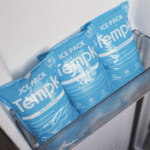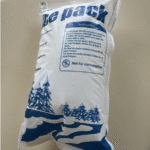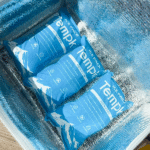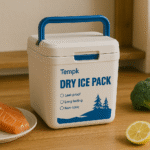For businesses handling temperature-sensitive products, dry ice pack sheets are a vital component in ensuring goods arrive fresh and undamaged, particularly for next-day shipping. Whether shipping food, pharmaceuticals, or biological samples, dry ice pack sheets are a reliable solution for maintaining the required temperature over extended periods. This article will cover how dry ice sheets enhance next-day shipping, their advantages, best practices for efficient use, and important regulatory considerations.
-
The key benefits of using dry ice in shipping perishable goods.
-
Best practices for using dry ice pack sheets effectively.
-
Regulatory considerations for shipping with dry ice.
Why Are Dry Ice Pack Sheets Ideal for Next-Day Shipping?
Dry ice, the solid form of carbon dioxide (CO₂), sublimates at a temperature of -78.5°C (-109.3°F). This property makes dry ice perfect for shipping perishable items that require consistent cooling during transit. Dry ice pack sheets offer an efficient and convenient solution for keeping products at the right temperature, especially for next-day delivery, where quick and reliable cooling is essential.
Using dry ice pack sheets helps preserve perishable goods by maintaining them frozen or refrigerated during shipping, even over long distances. With rising consumer demand for fresh, fast deliveries, dry ice is becoming an indispensable tool for businesses offering next-day shipping of temperature-sensitive goods.
How Do Dry Ice Pack Sheets Work for Next-Day Shipping?
Dry ice pack sheets work by absorbing heat as they transition from solid CO₂ to gas. This sublimation process allows the dry ice to keep items cold without the need for traditional refrigeration units. For next-day shipping, the ability of dry ice to stay cold for extended periods ensures that your products arrive on time and at the correct temperature, preventing spoilage and maintaining product integrity.
Key Benefits of Using Dry Ice for Next-Day Shipping
-
Efficient Cooling: Dry ice ensures that products stay at the correct temperature for longer periods, which is critical for perishable goods. With proper insulation, it can last through the entire shipping duration, even with expedited services like next-day shipping.
-
Cost-Effective: Using dry ice helps avoid the need for expensive refrigerated trucks or specialized cooling devices. Businesses save on shipping costs while ensuring that temperature-sensitive goods reach their destination safely.
-
Versatility: Dry ice pack sheets can be used for various types of shipments, ranging from food and beverages to medical supplies and biological samples. Their ability to maintain low temperatures makes them versatile across industries requiring reliable cold chain solutions.
Best Practices for Using Dry Ice Pack Sheets in Next-Day Shipping
How Much Dry Ice Should You Use?
The right amount of dry ice is essential for maintaining the required temperatures during transit. Typically, 5-10 pounds of dry ice are used for standard shipments. The exact quantity will depend on factors such as the shipping duration, the type of product being shipped, and the insulation used in the package. For next-day deliveries, you’ll want to ensure that the dry ice lasts long enough to maintain the product temperature throughout transit.
Pro tip: Always consult with your shipping carrier about dry ice weight limits, as there are regulations governing the maximum amount of dry ice allowed per package.
Packaging Tips for Dry Ice Pack Sheets
To maximize the effectiveness of dry ice pack sheets, follow these best practices for packaging:
-
Use Insulated Containers: Insulated containers slow down the sublimation rate of dry ice, helping it last longer and maintain the correct temperature.
-
Double-Bagging: Place dry ice inside a breathable bag to prevent direct contact with the product.
-
Seal Containers Properly: Ensure that containers are airtight to prevent CO₂ gas leakage but still have proper ventilation to allow for the safe release of CO₂ gas.
Ventilation is Key
When using dry ice, it’s essential to ensure proper ventilation. As dry ice sublimates, it releases carbon dioxide gas, which can create pressure inside sealed containers. To prevent ruptures or delays, use containers that allow CO₂ gas to escape safely.
Regulatory Considerations for Shipping with Dry Ice
Shipping with dry ice requires compliance with various regulations, such as those set by transportation authorities. Shipments containing more than 5.5 pounds of dry ice require specific packaging guidelines and labeling.
Key regulatory guidelines include:
-
Weight limits: Shipments containing dry ice may not exceed 5.5 pounds without meeting additional guidelines.
-
Proper labeling: Packages must be clearly marked with “Dry Ice” and “UN 1845.”
-
Shipping documents: Some shipments may require a dangerous goods declaration, depending on the amount of dry ice.
Benefits of Dry Ice vs. Other Cooling Methods
When compared to other cooling methods, dry ice offers superior cooling due to its extremely low temperatures and longer duration. While gel packs and ice packs are commonly used for refrigerated shipments, dry ice is the preferred choice for next-day deliveries requiring freezing temperatures.
| Cooling Method | Temperature Range | Cooling Duration | Best Use Case |
|---|---|---|---|
| Dry Ice | -78.5°C (-109.3°F) | 24-72 hours | Frozen food, biological samples |
| Gel Packs | -5°C to 5°C | 12-24 hours | Refrigerated items, short-duration shipping |
| Ice Packs | 0°C to -5°C | 6-12 hours | Short-term deliveries, grocery items |
How to Pack Food for Dry Ice Shipping
When shipping food, it’s essential to pack it properly with dry ice to ensure it stays at the required temperature. Here’s how to do it:
-
Use Sturdy, Insulated Boxes: Ensure the boxes are robust enough to withstand handling and maintain a consistent temperature.
-
Layer the Dry Ice: Place dry ice on the bottom or around the product to ensure even cooling.
-
Seal the Box with Ventilation: Ensure the box has ventilation holes to avoid pressure buildup from the sublimating CO₂ gas.
Trends in Dry Ice Shipping for 2025
As we move into 2025, several trends are shaping the future of cold chain logistics and dry ice shipping. Notable innovations include:
-
Smart Packaging Solutions: New technologies, such as real-time temperature monitoring, are becoming more common, ensuring that shipments stay within safe temperature ranges throughout transit.
-
Sustainability in Packaging: Companies are moving towards sustainable packaging options, reducing the environmental impact of shipping.
-
Integrated Cold Chain Solutions: Partnerships between logistics providers and tech companies are increasing efficiency and reducing costs.
Common FAQs about Dry Ice Pack Sheets for Next-Day Shipping
What are the best practices for shipping food with dry ice?
The best practices include using insulated packaging, properly layering dry ice around the food, and ensuring the box is ventilated to prevent gas buildup. Always check with your carrier for dry ice regulations.
Can dry ice keep my food frozen for the entire next-day shipping period?
Yes, if you use the right amount of dry ice and pack it in an insulated container, dry ice will keep your food frozen for the duration of next-day shipping, ensuring product quality.
Conclusion and Recommendations
Dry ice pack sheets are an essential tool for businesses offering next-day shipping for perishable goods. By following best practices for dry ice usage and staying compliant with shipping regulations, you can ensure that your products reach their destination safely and in optimal condition.
Next Steps for Your Business
-
Review your dry ice shipping strategy: Ensure you’re using the correct amount of dry ice and appropriate insulation.
-
Partner with specialized logistics providers: Work with carriers who understand the requirements for dry ice shipments to ensure safe and efficient delivery.
-
Stay up-to-date with regulations: Regularly check for updates to regulations regarding dry ice shipping to avoid delays or penalties.
About Tempk
At Tempk, we specialize in providing innovative cold chain solutions for businesses in industries that require temperature-sensitive shipments. Our dry ice pack sheets and insulated boxes are designed for easy training, repeatable packouts, and regulatory compliance. With our expertise, we help ensure the safe and efficient transport of goods, including those shipped with dry ice.
Consult with us today to learn how dry ice can improve your next-day shipping logistics.























